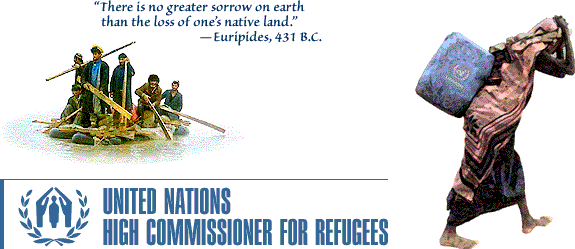AT A GLANCE
- 1,459 refugees crossed into Albania during the evening of 9
April, three days after Yugoslav authorities closed their borders with Macedonia (FYROM)
and Albania.
- On 9 April, around 650 displaced persons arrived in
Montenegro on foot, all coming from Istok municipality in Kosovo.
- High Commissioner Sadako Ogata extended her visit to Skopje
by a day. During her visit she met with the Macedonian (FYROM) President Gligorov and
other senior officals, as well as with representatives of donor nations and Ambassador
William Walker, head of the Kosovo Verification Mission.
THE EXODUS
1,459 Kosovar refugees were allowed to cross into Albania
late Friday evening at the Morini border post. The group, representing the entire
population of the village of Vragolija, located just west of Pristina, were ordered out of
their homes when security forces surrounded it earlier Friday, refugees told UNHCR. They
travelled the 150 km to the border in 114 cars and tractor-pulled trailers.
The refugees told UNHCR staff that they were first
instructed to leave on foot and then, after walking around 500 meters, were told to go
back to their homes to take their vehicles. Security forces then escorted the column the
entire way to the border, refugees said.
The group told UNHCR that most villages on the road to the
border post at Morini had been burned. They met no one on the road as they moved south but
at Djakovica civilians warned them not to continue, as others had "been taken from
the border into the mountains", the villagers said.
Yugoslav border police re-opened the checkpoint to allow
the group to pass, and Albanian officials had to register the new arrivals well into the
early morning hours, before they could proceed to Kukes town.
Early Saturday morning, another 76 refugees entered
Albania through Morini.
In Montenegro, UNHCR counted 650 new arrivals from Kosovo
during Friday, all from Istok, bringing the total number of displaced in the province to
61,000. They reached Rozaje on foot and told UNHCR staff that around 6,000 people in the
Jablanica area (of Pec municipality) were trying to work their way to Montenegro.
HUMANITARIAN EVACUATION
Airlifts of volunteers for evacuation among refugees in
Macedonia continued on Friday 9 April. More than 1,000 refugees travelled to Germany, to
Turkey, and to Norway. A UNHCR team in Brazda camp is using megaphones to inform refugees
of evacuation options, and registers volunteers who come forward, in particular to make
sure that families remain intact. An identical effort is planned for other refugee sites.
Another 1,000 refugees are expected to leave on Saturday
10 April for Germany, Poland and Turkey.
On Friday, the High Commissioner and the Director of
UNHCR’s Regional Bureau for Europe, Mr. Anne-Willem Bijleveld, briefed members of the
diplomatic corps in Skopje on the humanitarian evacuation operation.
The High Commissioner explained that UNHCR wished to
assist refugees as close as possible to their region of origin, for as long as this could
be done. Since the refugees who had been stranded in the no man’s land at Blace had
been shifted to camps in Macedonia and to Albania, she did not believe that the situation
currently warranted the urgent evacuation of refugees to overseas destinations. However,
voluntary evacuation to European destinations was continuing, and the High Commissioner
expressed deep appreciation for all of the offers which had been made to take in refugees.
Mrs. Ogata stressed that the situation remained very
volatile and unpredictable, with the risk of resumed expulsion of ethnic Albanians from
Kosovo at any time. UNHCR might therefore need to avail itself of the option of evacuation
to more distant locations (including outside of Europe) on very short notice, depending on
developments.
MRS. OGATA’S VISIT
In Skopje, the High Commissioner met Friday with President
Gligorov and senior members of the Macedonian government. She spoke with representatives
of the refugees in the capital and today will visit refugee sites and Macedonian host
families which have taken in refugees.
In her meeting with Ambassadors she stressed the urgent
need to support the numerous host families all over the former Yugoslav Republic of
Macedonia which have taken in refugees. More than half of all refugees in Macedonia are
staying with host families. She also underlined the need to support Macedonian
institutions and community structures.
Saturday morning Ogata discussed the situation inside
Kosovo with Ambassador William Walker, who headed the OSCE’s Kosovo Verification
Mission. She also met with NATO General Drewienkewicz.
|
 Kosovo
Crisis Update 10 April 1999
Kosovo
Crisis Update 10 April 1999  Kosovo
Crisis Update 10 April 1999
Kosovo
Crisis Update 10 April 1999  Document compiled by Dr S D Stein
Document compiled by Dr S D Stein